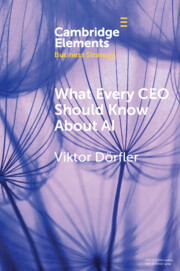Element contents
What Every CEO Should Know About AI
Published online by Cambridge University Press: 04 March 2022
Summary
Keywords
Information
- Type
- Element
- Information
- Series: Elements in Business StrategyOnline ISBN: 9781009037853Publisher: Cambridge University PressPrint publication: 05 May 2022
References
Accessibility standard: Unknown
Why this information is here
This section outlines the accessibility features of this content - including support for screen readers, full keyboard navigation and high-contrast display options. This may not be relevant for you.Accessibility Information
- 16
- Cited by
